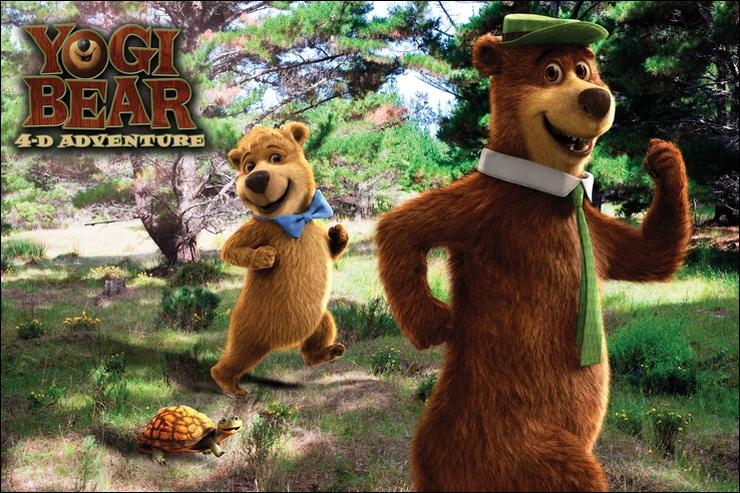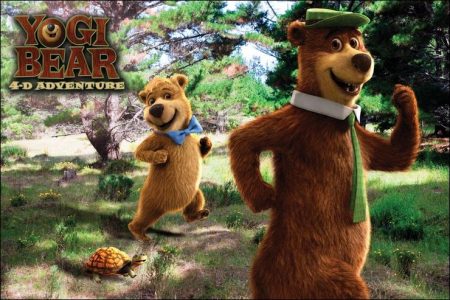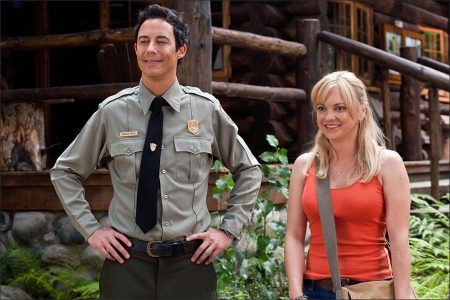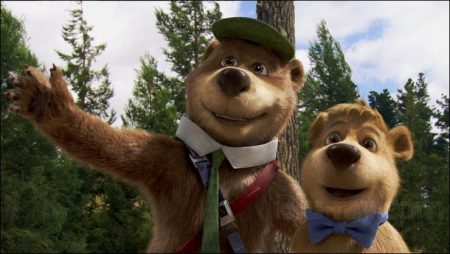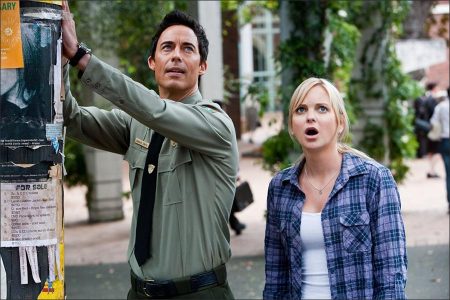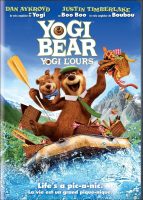Taglines: Life’s a pic-a-nic.
Everyone’s favorite pic-a-nic basket-stealing bear comes to the big screen in “Yogi Bear.” Jellystone Park has been losing business, so greedy Mayor Brown decides to shut it down and sell the land. That means families will no longer be able to experience the natural beauty of the outdoors — and, even worse, Yogi and Boo Boo will be tossed out of the only home they’ve ever known.
Yogi has always relied on his quick wit and fast feet to stay one step ahead of irate campers while dodging his long-suffering nemesis, Ranger Smith. But he and Boo Boo are about to face a situation worse than anything Yogi has ever gotten them into… Jellystone Park is being sold!
To cover his mismanagement of city funds and fuel his election campaign, Mayor Brown plans to sell the park to loggers. Families will no longer be able to experience the natural beauty of the outdoors Jellystone has always provided—and, even worse, Yogi, Boo Boo, and all their friends will be tossed out of the only home they’ve ever known. Faced with his biggest challenge ever, Yogi must prove he really is “smarter than the average bear,” as he and Boo Boo join forces with Ranger Smith to find a way to save the park from closing forever.
Yogi Bear is a 2010 American 3D live-action/computer-animated family comedy film directed by Eric Brevig, produced by Donald De Line and Karen Rosenfelt, written by Brad Copeland, Joshua Sternin and Jeffrey Ventimilia and based on the animated television series The Yogi Bear Show and the character created by William Hanna and Joseph Barbera. The film stars Dan Aykroyd, Justin Timberlake, Anna Faris, Tom Cavanagh, T.J. Miller, Nate Corddry and Andrew Daly with narration by Josh Robert Thompson. The movie tells the story of Yogi Bear as he tries to save his park from being logged. Principal photography began in November 2009. It was preceded by the cartoon short Rabid Rider, starring Wile E. Coyote and the Road Runner.
Yogi and Boo Boo
Yogi Bear and Boo Boo made their first appearance on the small screen in 1958 as part of Hanna-Barbera’s “The Huckleberry Hound Show,” the first cartoon series ever to earn an Emmy Award for Distinguished Children’s Programming. The pair’s popularity soon launched their own spin-off show, in 1961, followed by a nationally syndicated comic strip and, in 1964, their big-screen debut. In the ensuing years, the carefree mooch and his sweet-natured pal have been spotted in numerous series, specials, movies and DVD collections.
Throughout, one theme has remained constant: friendship. No matter what’s at stake or whether or not Yogi’s latest contraption will crash-land the two of them through the roof of the ranger station, at the heart of every “Yogi Bear” tale is the abiding camaraderie and comedic interplay between Yogi and Boo Boo. And their latest adventure is no exception.
“It’s about loyalty. In the end, your friends are your friends and you gotta stand by them,” says Aykroyd.
“Their dynamic is wonderful to watch,” Brevig says. “Yogi always convinces Boo Boo that his latest and greatest plan is going to work, never mind that it never does. And Boo Boo is the devoted friend who’s always there for his big buddy. He often tries to suggest a more sensible route—to no avail—and he usually gets the worst of the deal when things fall apart, but he still hangs in there.”
As many savvy viewers have come to understand, Boo Boo may really be the one who’s smarter than the average bear, though it’s a point he would never dream of pressing. “Boo Boo is definitely Yogi’s conscience,” Timberlake notes. “He’s the good angel on Yogi’s shoulder, always there to remind him of what’s important. But even as he’s the voice of reason, he does it all while being a cute little bear with a nasal-y voice.”
“Yogi makes every crazy idea sound so attractive because of his enthusiasm, that Boo Boo always ends up going along with it, no matter how dangerous or ill-advised,” says Aykroyd, who laughingly cites a prime example: “One of my favorite scenes is Yogi up on a cliff, hooking himself up to a zip line. He actually thinks he has accurately targeted a picnic basket, and you know that’s not going to happen…”
But what Yogi lacks in engineering acumen, he makes up for in charisma. He may be a tad vain, impulsive and sticky-fingered, but we love him because he’s also decent, kindhearted and endlessly optimistic.
“Yogi’s charm stems from his basic civility. He may be a thief but he’s a very courteous thief and that’s why no one, not even Ranger Smith, can truly hold it against him. His positive attitude and can-do spirit is infectious,” says Jeffrey Ventimilia, who, with writing partner Joshua Sternin, shares screenwriting credit on “Yogi Bear.”
“There’s also a subtle subversiveness to Yogi that I think is part of his appeal to adults,” Sternin adds. “While the rest of us have to live by society’s rules, he has an admirable sense of freedom. He lives by his own rules, acting in the moment.”
Recalling his meeting with the actor, Brevig adds, “I can’t say we found our Yogi Bear because our Yogi found us. He started reading lines and if you were looking at him, you’d think, ‘That’s Dan,’ but if you turned away, you’d think, ‘That’s Yogi.’” The filmmakers were also delighted with Timberlake’s take on Boo Boo. “Donald, Karen and I met with him,” Brevig recounts. “We all know he’s a multi-talent, an impressive actor with a great voice, but would this be in his skill set? People think they can do Boo Boo but it’s not easy. As we were talking, he casually dropped into character and we just stopped and looked at each other. He was fantastic.’”
Timberlake, whose film credits include a starring role as the voice of Artie in the 2007 blockbuster hit “Shrek the Third,” says, “I always used to walk around the house imitating all kinds of cartoon voices. I would mimic everything, and so I was happy to give Boo Boo a try.”
“Like Dan, Justin has real gift for comedy,” says De Line. “They played around with the dialogue at their initial meeting and right away they hit all the beats and had a good time with it.”
Fortunately, their schedules lined up such that the actors were able to work together in the same space, an uncommon occurrence in the animation world, where isolated solo recordings are the norm. That not only facilitated a genuine rapport between the leads, but a fair amount of ad-libbing as well.
“I think it made a difference to the performances because Yogi and Boo Boo work so well as a left and right hand. I consider them a classic team like Abbott and Costello or Laurel and Hardy,” says Timberlake. “Dan had the perfect energy and working together created the opportunity for us to improv a bit.”
Aykroyd concurs, adding, “Whenever you have artists collaborating there’s going to be some improvisation, you’re going to go off on riffs. There were a lot of moments when we made stuff up on the spot. It was wonderful to have the opportunity to play off each other, and to chuckle about how funny it was to be there, in our adult lives, playing these characters that we loved as children.”
Brevig banked preliminary voice recordings for the animators’ reference before beginning the live-action portion of the project. Meanwhile, on the Jellystone Park set in New Zealand, the live-action stars began playing to an imaginary Yogi and Boo Boo.
“When you have a big CG character interacting with actors it requires a lot of planning, but you also have to think on your feet,” says Rhythm & Hues animation supervisor Joe Ksander (“Night at the Museum”), whose on-set work included providing eye-line references and guiding the stand-ins. Ksander and animation supervisor Alex Orrelle (“The Incredibles”) worked in tandem with Brevig and Rhythm & Hues’ visual effects supervisor Betsy Paterson (“The Incredible Hulk”) as part of a team numbering approximately 450 at its peak, keeping pace with one another between Los Angeles and New Zealand via Cinesync and Skype.
Pre-filming run-throughs gave the actors an idea of what their animated colleagues would be up to at any given moment, and provided Brevig and the animators additional ideas for actions and reactions. Says Orrelle, “It was a very collaborative environment. You never know where a great idea will come from, and Eric was always flexible.” As scenes were shot, simple cartoon versions of Yogi and Boo Boo were digitally drawn into the footage to provide a guide for the CG animators, “based on cues from the director as to the intent of each sequence and what Yogi and Boo Boo would be feeling,” he adds.
The edited footage was then screened for Aykroyd and Timberlake. At that point, “It was like video-game versions of the characters so the actors could see if they were standing, running for a train or hanging on the edge of a cliff,” Brevig explains. “I told them, ‘This is my best guess of what you’re going to do. Your performances are now going to tell us how to change the animation.’”
It wasn’t until after the two completed their scenes that their characters really began to come alive, calibrated by the animators to the pacing and nuance of the vocal and physical performances—quizzical where they were quizzical, hushed where they hushed, and exuberant where they were exuberant. Yogi and Boo Boo became increasingly more refined and integrated with their human co-stars, ultimately acquiring the emotion as well as the textures, colors and natural movements seen on screen.
Ksander acknowledges that filming in 3D “means we can’t cheat. We have to be more careful about exactly where the bears are. If they need to be a certain size that meant, on set, we’d have to work closely with the camera crew and the actors to be sure that the bears no one can actually see are in the right place.”
Production was planned so that Brevig was able to edit and oversee the computer animation and effects in their post-production phases while concurrently shooting liveaction sequences with the actors in New Zealand, a process he jokingly likens to “laying track as the train is coming.”
Grin and Bear It
Mr. Ranger isn’t gonna like this…
If Yogi is the unstoppable force, Ranger Smith is the immovable object in his path. With all his rules and regulations—plus a never-ending supply of signs advising PLEASE DON’T FEED THE BEARS—Smith is the law in Jellystone Park. Which means, in addition to devising ever-more-ingenious ways of helping himself to forbidden food, Yogi must always think of ways to evade this protector of park patrons—a man he respectfully addresses as “Mr. Ranger, Sir,” when he’s caught red-handed…red, as in cherry pie.
“Yogi is the bane of the ranger’s existence. Smith is trying to entice visitors to the park, where Yogi does his best to steal their food. It’s a constant battle,” Brevig states.
Tom Cavanagh sees Smith as “a man who loves the great outdoors, all its flora and fauna, and lives for his park. He was raised by his father to be a park ranger, and comes from a long succession of Rangers Smith, so he’s committed.”
“Tom is so good at portraying the long-suffering good guy you root for,” the director continues. “He’s funny, but at the same time you have to take him seriously. Ranger Smith is a touchstone for the audience. He’s the only person in the story you can relate to as almost a normal guy, dealing with all the crazy characters around him. And, like Smith, Cavanagh has a wonderful way of being consistently enthusiastic, warm and charming, while reacting to things like Yogi accidentally dropping a rock on his head.”
The actor compares Smith’s relationship with Yogi to “having a brother or a friend who always gets into trouble and makes a mess, but you still like him. For all his bluster, Ranger Smith doesn’t have the heart to stay mad at Yogi. The truth is, Yogi does entertain him, though he’d never admit it.”
“They’re kind of harmoniously interconnected; each one justifies the other’s existence,” says Aykroyd.
Perhaps the funniest thing about the ranger is his touching belief that, one day, Yogi might actually heed his advice, stop raiding campsites and start acting like, well, a regular bear. So he is none too pleased to discover that the park’s biggest liability is going to be the star subject of a documentary by filmmaker Rachel Johnson, one of several new characters “Yogi Bear” introduces to Jellystone. The last thing that bear needs, Smith feels, is attention. It will only encourage him.
But the ranger’s reservations are soon swept aside by the undeniable impact Rachel makes on him. Not only is she beautiful and smart, but her most ardent interests happen to be the same botanical and zoological realms that consume his own waking hours. A woman who knows a Datura Stramonium from a Lygodium Palmatum…and looks like that? What are the odds?
Anna Faris, who plays the role of the visiting filmmaker, says, “Rachel is passionate about animals. She’s lived with all kinds of wildlife to film her documentaries and now she’s at Jellystone because she heard they have a couple of talking bears. This is supposed to be a rare thing, as opposed to completely impossible. The fact that they can talk at all doesn’t really seem to faze anyone.”
“We’d seen Anna’s work and thought she was wonderfully funny, and would be perfect for this kooky character,” says Brevig. “Rachel wants footage of Yogi and Boo Boo in their ‘natural’ habitat, which is ridiculous because they live in a furnished cave complete with a TV set.”
It turns out that Rachel and Smith have more in common than their identical dogeared copies of The North American Wilderness Guide. Since her career keeps her mostly in the wild, Rachel’s unfamiliarity with human company proves a good match for the smitten ranger’s awkward attempts at conversation. Says Faris, “They’re both nerdy, but in a good way.”
When Rachel learns the park is in peril, she offers to help. And Smith can use all the help he can get, since his over-enthusiastic and over-confident deputy, Ranger Jones, can be more of a hindrance.
Cast as Jones, T.J. Miller believes, “The problem is that the deputy, who carries a collection of Boy Scout merit badges as proof of his worth, wants to be an expert on everything. He’s an interesting character because he’s a combination of goofiness and a drive for power. Simply put, he wants Smith’s job but he’s not ready for it.”
“It’s a tricky role because Jones is fooled by the mayor into helping him,” says Brevig. “T.J. and I worked to figure out the exact tone, because we didn’t want Jones to be a bad guy. He’s just gullible and the mayor takes advantage of that, so we’re rooting for Jones to do the right thing, even when he makes the wrong choices.”
Brown is played by Andrew Daly, who gives the mayor’s villainy a casual feel, explaining, “He’s just going about his business. He has a long list of things to do today, and destroying Jellystone Park is only one of them. He’s not doing it out of any hatred of nature or vengeance against anyone, but rather because it happens to suit his agenda.” “What I love about Andrew’s performance is that he so delights in everything he’s saying, especially if it’s evil. He has such a twinkle in his eye,” Brevig says.
Supporting the mayor in his intent to turn Jellystone’s majestic Redwoods into a lumberyard is his Chief of Staff, played by Nate Corddry, a role identified by a title alone because, Daly notes, “The mayor doesn’t know his name. He regards him as a piece of office equipment, like a copier, and doesn’t know anything about him as a human being.”
“The plan is to come into this big, beautiful park and chop down all the trees, which would not be a good thing for picnickers or talking bears,” says Corddry. “But the Chief of Staff is the mayor’s right-hand man. Whenever he hatches an evil plot, it’s my character’s job to deliver.”
Brevig sees the mayor and his flunky as “a pair of dysfunctional characters who don’t realize how goofy they are. The fun of watching them is that they’re not very good at what they’re doing. They’re bad guys, for sure, but they’re really bad bad guys.”
Jellystone Park
Production began on location at Woodhill State Forest, a popular mountain biking destination covering approximately 36,000 acres, west of Auckland, New Zealand. “It was important to me that the actors were in a natural setting, especially on a film with CG characters,” says Brevig. “We could have used a lot of green screen but we wanted to capture the spirit of the outdoors, so we dragged our fancy technical equipment out to where the beauty of nature actually exists and filmed it there.”
“Luckily, since our production schedule began in November, it was the New Zealand spring so we had stunning scenic locations and perfect weather,” says De Line. That’s not to say Woodhill didn’t need a bit of sprucing up to become the world of Jellystone. For starters, Brevig states, “It’s a pine tree plantation, where they grow pine as a lumber crop, meaning equally spaced trees planted in neat rows.” To this base, production designer David R. Sandefur and head greensman Russell Hoffman added locally sourced mature Japanese cedars, which closely resemble California Redwood, plus nearly 10,000 ferns, multiple flats of grasses and mosses, truckloads of rocks and logs, and bales of pine needles. Hundreds of potted plants from nurseries were interspersed with transplanted conifers to create a lush canopy.
The lake on which Yogi stages a hilariously ill-conceived waterskiing and fireworks show was shot at the Whakamaru reserve in the country’s central North Island, between the cities of Rotorua and Taupo. For the film’s climactic whitewater rafting scene that propels Yogi, Boo Boo, Ranger Smith and Rachel through the rapids, the production used nearby Waikato River, where they created perilous rapids by coordinating with a local hydroelectric plant that uses the river to provide electricity to the region. When it opened its floodgates at the Aratiatia Dam at daily two-hour intervals, the filmmakers took advantage of the rushing water to launch their raft.
“People can attest that I did some of my own stunts for the whitewater sequence,” Tom Cavanagh announces with mock bravado. “Not because I was daring, but because at one point the raft carrying the stunt guys flipped, so we just got into the next one. Was it smart? No. Was it fun? Yes…in an absolutely terrifying way.”
“It was a little insane, but wonderful. It was beautiful out on the water and I think those were my favorite days of the shoot,” Faris agrees.
The scene was completed against a blue screen. Visual effects supervisor Betsy Paterson says, “We got a lot of footage on the river but there are always bits and pieces to add. Then we had to put Yogi and Boo Boo in. They needed to look scared; they needed to look like they were holding on for dear life. So we fit them in between Ranger Smith and Rachel and gave them some fun things to do.”
Jellystone’s other points of interest include the bears’ cave and the ranger station, for which Sandefur had his work cut out for him. “The cartoon was so stylized and surreal. The landscapes were sort of abstract and the color palette was all over the place. It bore no resemblance to reality. Here, the bears have to exist in a live-action world, yet, when we’re in their environment, like the cave, we want to pay homage to details from the cartoon. So it was a real challenge to reconcile the two,” he explains.
Of course, any Yogi fan knows that what makes his and Boo Boo’s home so special are the one-of-a-kind upgrades Yogi has made on the place through the creative repurposing of items found in—and pilfered from—the park. Sandefur furnished the bears’ lair with what he calls “fantastical objects fashioned from ordinary items that, in theory, he could have lifted from campers, trailers and park personnel. I wanted to retain a fantasy aspect to it, but I couldn’t just start dragging things in there that made no sense.”
Sandefur employed the Rube Goldberg school of design in constructing Yogi’s outlandish inventions, like a pie-delivery catapult or The Basket Nabber 2000, a pedal-driven glider with tent fabric for wings, canoe paddles as propellers and a red wagon for landing gear. Says Brevig, “David was brilliant at assembling these contraptions so they actually seemed to work…until they didn’t. There’s always a problem with Yogi’s inventions. He tends not to think them all the way through so something always goes wrong.”
Another familiar spot for fans is the ranger station, a log cabin with the look of a 200-year-old building that was built on site, from the ground up. “Everyone who saw it wanted to buy it,” states Cavanagh, who includes himself among them. When production wrapped, the cabin was purchased and relocated by a company that operates a tourist railway in neighboring Rotorua.
Consistent with Sandefur’s design parameters, costume designer Liz McGregor also aimed for a look that wasn’t obviously retro but, rather, defies dating. “I was working with a very specific image of Ranger Smith from the cartoon series, as well as the National Park Service’s actual uniform, and decided to amalgamate the two,” she says. “All the insignia was based on NPS badges and designs but reworked to read ‘Jellystone.’”
Brevig visited California’s Yosemite National Park in preparation for “Yogi Bear,” and reflects that “Jellystone is kind of the idealized version of these places around the world and all that they have to offer. One of the interesting things about our parkland is how time essentially stands still there, and we tried to replicate that in the movie. From the opening frame, audiences should feel as if they’re in Yogi’s world and in Jellystone Park, the most gorgeous park imaginable, with a couple of bears who are determined to keep it that way.
“I hope everyone who sees it will remember the feeling they had when they watched the original cartoon,” Brevig concludes. “I hope that they’ll be able to share that feeling with their kids.”
Yogi Bear (2010)
Directed by: Eric Brevig
Starring: Dan Aykroyd, Justin Timberlake, Anna Faris, Tom Cavanagh, T.J. Miller, Nate Corddry, Josh Robert Thompson, David Stott, Greg Johnson, Patricia Aldersley, Tim McLachlan, Dean Knowsley
Screenplay by: Jeffrey Ventimilia, Joshua Sternin, Brad Copeland
Production Design by: David Sandefur
Cinematography by: Peter James
Film Editing by: Kent Beyda
Costume Design by: Liz McGregor
Set Decoration by: Daniel Birt
Art Direction by: Jules Cook, Jill Cormack
Music by: John Debney
MPAA Rating: PG for parental guidance.
Studio: Warner Bros. Pictures
Release Date: December 17, 2010
